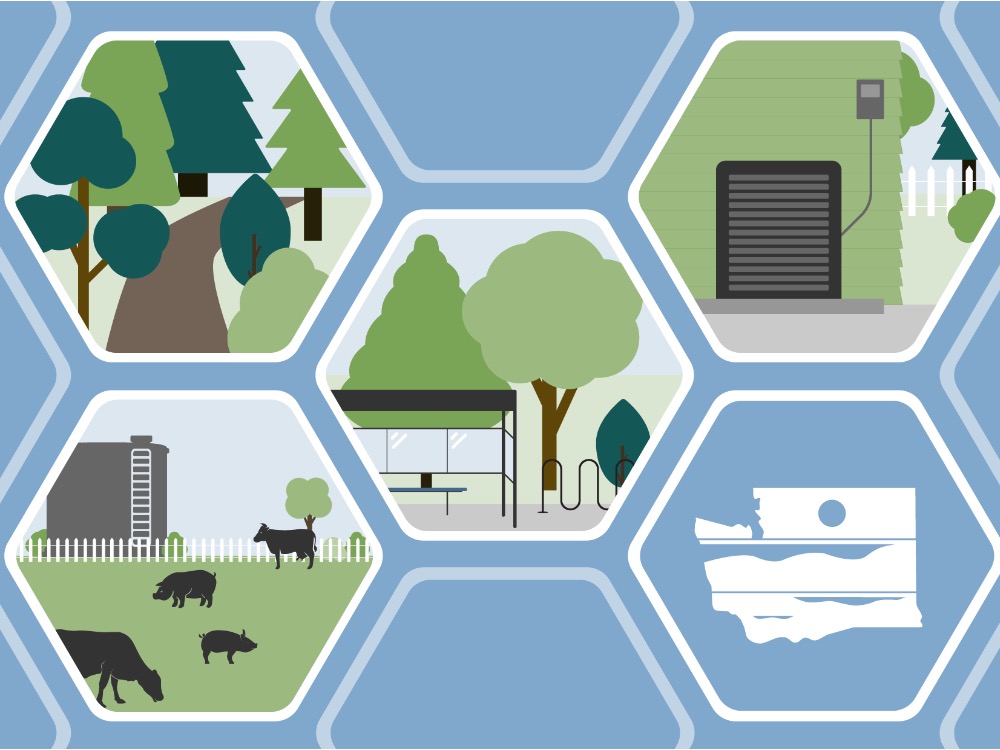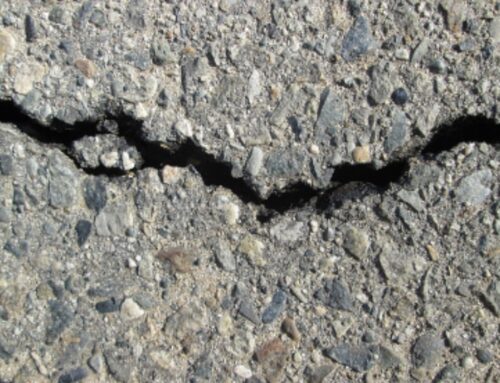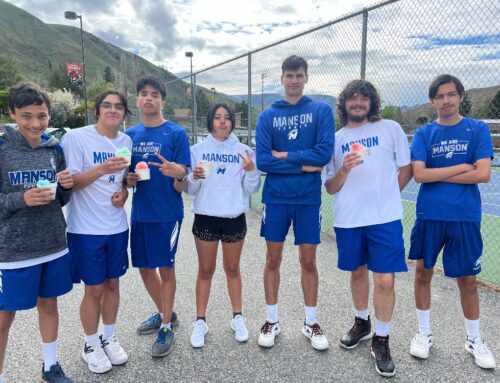DOE Reports on Washington’s carbon offset program
information released by Washington Department of Ecology
We’re starting off the year with big news for Washington’s carbon offset program! On Dec. 19, 2023, Ecology issued the first cap-and-invest offset credits for two offset projects providing direct environmental benefits to our state.
The two offset project developers, A-Gas US and Tradewater, were issued a combined 249,136 Ecology offset credits. Each credit represents one ton of carbon dioxide equivalent not emitted into the atmosphere. We’ll get to the details of those projects in a moment, but first, let’s learn a bit more about offset credits and projects.
Under Washington’s Climate Commitment Act (CCA), entities that emit large amounts of carbon pollution (emitters) in our state are required to purchase or obtain emissions allowances equal to the greenhouse gases they produce. A portion of that obligation can be met through offset credits. The offset credits are obtained from projects that will result in greenhouse gas reductions or removals that are permanent and verifiable. Offset credits are a potentially lower-cost way for emitters to comply with the program. In cap-and-invest programs similar to Washington’s, offset credits typically sell for less than allowances purchased at an auction, creating an incentive for emitters to invest in these projects. After a project is developed, a project developer can apply to Ecology to earn offset credits. Businesses not required to participate in the cap-and-invest program may also choose to purchase offset credits to voluntarily offset their greenhouse gas emissions.
While Ecology issues and tracks offset credits, all offset credit transactions happen directly between the buyer and seller. Ecology does not generate revenue from selling offset credits. The number of offset credits sold in any particular transaction, and who buys them, is considered confidential information under the CCA, and is legally protected. For businesses looking to buy Washington offset credits, there are offset brokers and trade publications that may provide price estimates once the market develops and sufficient offset credit transactions occur.
Ecology will publish the total quantity of offsets used for compliance and reduce the next year’s total allowance budget for Washington by that amount. By reducing the allowance budget in proportion to offsets used, we ensure that offset credits in Washington’s cap-and-invest program are “under the cap” and do not allow greenhouse gas emissions over our annual allowance budgets. This helps keep us on track to meet our commitment to reduce emissions in Washington by 95% by 2050..
How many offset credits can businesses use to cover their emissions?
In the first compliance period (2023-2026), a business can generally cover up to 8% of the emissions with offset credits through a combination of general offset credits and credits from projects on federally recognized Tribal lands. These percentages will be reduced to 6% during the six remaining compliance periods (2027-2049). There is an annual limit on offsets to ensure that businesses are still investing in reducing their emissions and decarbonizing their operations over time. If Washington were to link carbon markets with California and Québec, the percentage of offset credits a business can use to cover their emissions would not change.
What are Direct Environmental Benefits?
Under the CCA, offset projects are required to provide “direct environmental benefits” to Washington. Even though the primary role of offsets is to reduce climate change, which is a global problem, the projects also often provide benefits to their local communities. All in-state offset projects are considered to provide direct environmental benefits to our state. There are some cases where an out-of-state project may be determined to provide direct environmental benefits to Washington, in which case additional documentation is required.
Washington’s four offset protocols
1. Ozone Depleting Substance Protocol
The first two offset projects issued credits by Ecology were both focused on finding and destroying ozone-depleting chemicals. The Ozone Depleting Substances Protocol allows offset credits to be generated for projects like this – generally aimed at substances like chlorofluorocarbons (CFCs). CFCs are gases that have been globally phased out of production but still exist in storage, and in legacy refrigeration units, from which they can leak into the atmosphere.
Although CFCs are infamous for the damage they did to the Earth’s ozone layer, they are also potent greenhouse gases – the global warming potential of these gases ranges from 2,000 to nearly 15,000 times more than carbon dioxide.
Under this protocol, the ozone depleting substances are sourced from old refrigeration systems, warehouses, and industrial sites and then taken to a specialized facility equipped to destroy the substances – which eliminates most of the threat they pose to the climate. There are a limited number of facilities in the United States that can do the job, and the CFCs from our first offset projects were destroyed at a facility in Ohio. To demonstrate that these projects provide direct environmental benefits to the state of Washington, a verified portion of the ozone depleting substances destroyed in each project must come from sites within Washington.
The offsets generated through this protocol are quantified by calculating the global warming potential of the destroyed substances, and subtracting the global warming potential of substitute refrigerants used and emissions generated by the transport of these substances to the destruction facility.

An example of an ozone destruction facility.
2. U.S Forestry
The U.S. Forestry Protocol allows for the granting of carbon credits through the sequestration of carbon in forests, and includes reforestation, conserving a forest under threat (such as being logged or taken down for a development), and improved forest management projects.
3. Urban Forestry
The Urban Forestry Protocol provides methods to quantify and report greenhouse gas emissions removal from planting and maintaining trees in urban areas. This sequesters and stores carbon as the trees grow, providing not only climate benefits but also a host of additional benefits to the air, water, soil, and ecosystems in our population centers.
4. Livestock projects
The livestock projects protocol is designed to reduce greenhouse gas emissions that result from anaerobic manure treatment at dairy cattle or swine farms. Farms may install a specialized “digester” tank that helps break down manure and captures the methane gas. The captured methane, or biogas, is then used for heat or fuel.
How are Washington offset projects developed?
To receive Washington offset credits, a project must go through several steps. First, the developer lists the project with an approved Offset Project Registry. Currently, the Offset Project Registries available in Washington are Climate Action Reserve and American Carbon Registry. The project then completes the emissions reduction or removal action – whether that’s the destruction of ozone depleting substances, placing a forest in a conservation easement, or installing an anaerobic digester. Next, the project goes through an Ecology-approved offset verifier to complete a third-party verification. The verifiers check that the project has complied with all the requirements in the offset protocol. Finally, Ecology will do a review of the project, determine whether the project provides direct environmental benefits to Washington and complies with all other program requirements, and approve the offset credits. At this point, the credits are issued and available for purchase.
We maintain an inventory of Washington offset projects and credits as they are issued on the Washington Offset Projects and Credits section of our offset webpage. We expect to issue more credits throughout the year as additional projects are verified.
What are safeguards to ensure emissions reduction is long-lasting?
Offset project developers have a responsibility to maintain the integrity of their project and ensure emissions reduction does not suddenly change. Ecology has the authority to invalidate offset credits if the credits have been found to have resulted from a project with a material misstatement of emissions reductions, or if the project violates any local, state, or federal law or regulation.
In addition, as stated above, offsets in Ecology’s program are “under-the-cap” which means that when an offset is used for compliance, a corresponding emissions allowance is removed from the market and permanently retired. This ensures that an entity’s use of offsets does not impact the state’s ability to achieve its emissions limits.
We also have the ability to reduce offset use for entities that significantly contribute to the cumulative air pollution burden in overburdened communities, ensuring that those entities reduce their emissions as quickly as possible.
For more information about Ecology’s Offsets Program, visit our Cap-and-Invest Offset webpage. If you’re interested in updates about the offset program and the Climate Commitment Act in general, subscribe to the Climate Commitment Act Bulletin.








